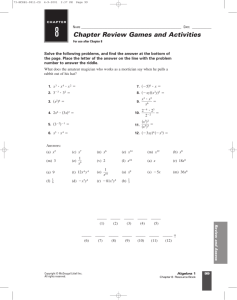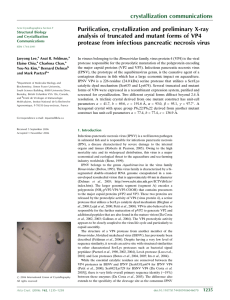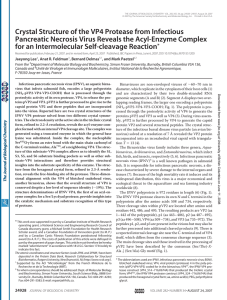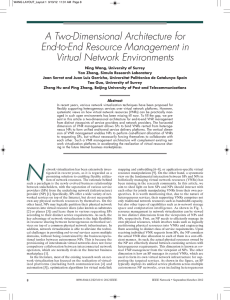at Operator Naokant Deo 1
advertisement
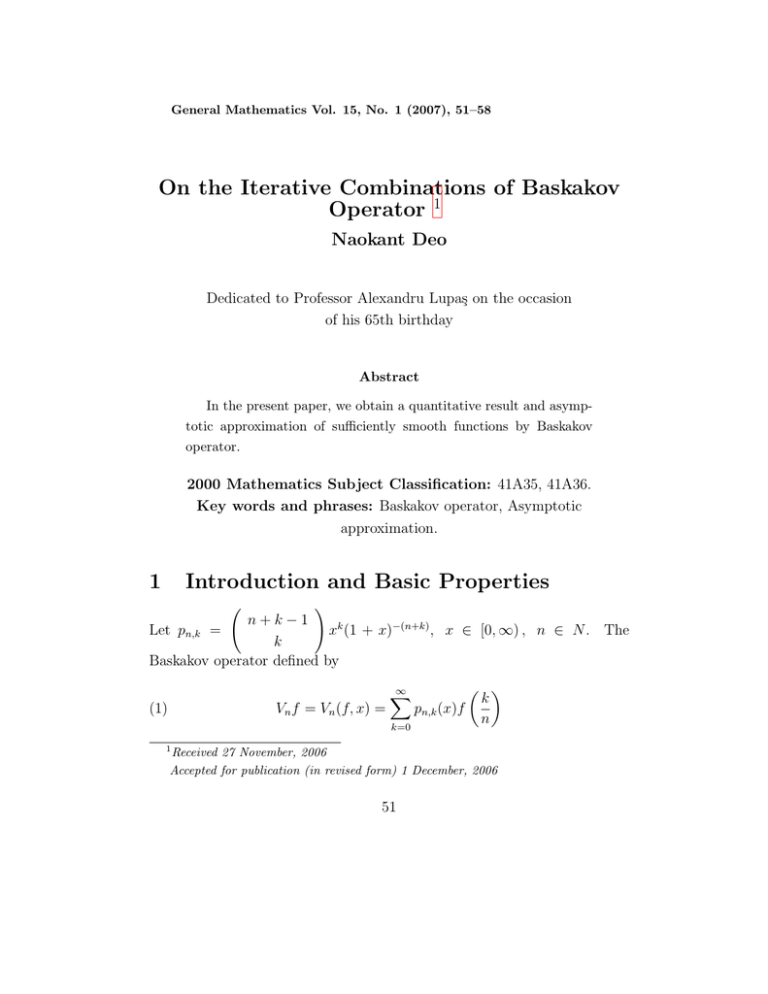
General Mathematics Vol. 15, No. 1 (2007), 51–58
On the Iterative Combinations of Baskakov
Operator 1
Naokant Deo
Dedicated to Professor Alexandru Lupaş on the occasion
of his 65th birthday
Abstract
In the present paper, we obtain a quantitative result and asymptotic approximation of sufficiently smooth functions by Baskakov
operator.
2000 Mathematics Subject Classification: 41A35, 41A36.
Key words and phrases: Baskakov operator, Asymptotic
approximation.
1
Introduction and Basic Properties
Ã
!
n+k−1
Let pn,k =
xk (1 + x)−(n+k) , x ∈ [0, ∞) , n ∈ N . The
k
Baskakov operator defined by
∞
X
µ ¶
k
pn,k (x)f
Vn f = Vn (f, x) =
n
k=0
(1)
1
Received 27 November, 2006
Accepted for publication (in revised form) 1 December, 2006
51
52
Naokant Deo
the operator (1) was introduced by V. A. Baskakov [2] and can be used to
approximate a function f defined on [0, ∞).
In the present paper, we consider iterative combination due to Micchelli [6] for the operators Vn , defined by (1) and obtain the quantitative
result as well as study the asymptotic approximation of sufficiently smooth
functions by these operators. Few researchers studied iterative combinations on the different operators (see [1], [3]). For f ∈ C[0, ∞), we define the
operators Tn,k (f, x) as
h
i
(2) Tn,k (f, x) = I − (I − Vn )k (f, x) =
k
X
k=1
(−1)r+1
Ã
k
r
!
Vnr (f, x),
where Vnr denotes the r − th iterate (superposition) of the operator Vn . As
far as the degree of approximation is concerned, the behavior of operator
Vn is similar to the exponential type operators.
Analogous manner of [4], for r = 1, 2, ..., we get
(3)
Vnr (1; x) = 1,
(4)
Vnr (t; x) = x,
(5)
Vnr (t2 ; x)
½µ
¾
¶r
¶r
µ
1
1
2
x +
1+
− 1 x.
= 1+
n
n
Let m ∈ N0 = {0, 1, ...} , p ∈ N = {1, 2, ...} and [β] denote the integral
{p}
part of β. Now, suppose that the m − th order moment µn,m (x) of Vnp be
defined by
m
p
(6)
µ{p}
n,m (x) = Vn ((t − x) ; x) .
{1}
We shall write
³ µn,m (x) ´for µn,m (x) and let Q(j, k, x) denote the coefficient
−k
of n in Tn,k (t − x)j ; x .
On the Iterative Combinations of Baskakov Operator
2
53
A Set of Lemmas
To prove of main results we need the following results:
Lemma 2.1. Since the degree of µn,m (x) is n−1 , which is less than or equal
to m with
´
³
−[ m+1
]
2
.
µ (x) = O n
n,m
The coefficient of n−m in µn,2m (x) is (2m − 1)!!pm (x), where a!! is the semifactorial of a and p(x) = x(1+x). Also, the coefficient of n−m in µn,2m+1 (x)
is (2m + 1)!!(m/3)pm (x)p′ (x).
Proof. Since Baskakov operator is exponential type operator, the proof of
this lemma follows from May [5, Proposition 3.2].
{p}
Remark 2.1. Now from Lemma 2.1, it is clear that the degree of µn,m (x)
{p}
less than or equal to m and µn,m (x) is defined by (6).
Lemma 2.2. There holds the recurrence relation
Ã
! m−j
m
X
X 1 di ¡
¢
m
{p+1}
{p}
µn,m
(x) =
(7)
µ
(x)
µn,i+j (x).
n,m
i
i!
dx
j
j=o
i=0
Proof.
Ã
m
P
=
j=o
Ã
m
P
=
j=o
sult (7).
{p}
{p+1}
By!definition of µn,m (x), we have µn,m (x) = Vn (Vnp (t − x)m ; x)
³
³
´ ´
m
j
m−j
p
;u ;x
Vn (u − x) Vn (t − u)
j
! µ
´ ¶
m−j
P (u−x)i+j di ³ {p}
m
µn,m−j (x) ; x . This leads to require reVn
i!
dxi
j
i=0
{p}
Lemma 2.3. Again from the definition of µn,m (x), we have
´
³
−[ m+1
2 ]
(8)
.
(x)
=
O
n
µ{p}
n,m
54
Naokant Deo
Proof. From Lemma 2.1, this result is true for p = 1. Now we assuming
{p}
the result for a certain p, we have to prove it for p + 1. Since µn,m−j (x) =
´
³
m−j+1
{p}
(x) ≤ m − j, it follows that
O n−[ 2 ] and the degree of µ
n,m−j
´
´
³
di ³ {p}
−[ m−j+1
] .
2
µ
(x)
=
O
n
dxi n,m−j
Thus, from (7), we have
!
Ã
m m−j
P
P −([ m−j+1 ]+[ i+j+1 ])
{p+1}
2
2
µn,m (x) = O
n
j=0 i=0
!
Ã
m m−j
P
P −[ m+i+1 ]
2
,
=O
n
j=0 i=0
the result (8) is immediate.
Lemma 2.4. The l − th moment (l ∈ N ) of Tn,k , we have
¡
¢
¡
¢
Tn,k (t − x)l ; x = O n−k .
(9)
Proof. From Lemma 2.1, the result easily holds for k = 1. Now assuming
that the result (9) holds, for certain values of k, then from Lemma 2.2
and 2.3, it may be seen that it also holds for k + 1.
3
Main Results
In this section, we first prove the following result.
Theorem 3.1. Let f ∈ C[0, ∞) and [0, b] ⊆ [0, ∞), then for all n
"
(10) kTn,k (f ) − f k 6 ω(f ; n−1/2 ) (2k − 1) + nξ
(µ
1
2+
n
¶k
− 2k
)#
where ω(f, .) is the modulus of continuity of f and k.k is the supremum
norm.
On the Iterative Combinations of Baskakov Operator
55
Proof. From (2) and (3), we obtain
Tn,k (f ; x) − f (x) =
k
X
(−1)r+1
r=1
Ã
k
r
!
Vnr (f (t) − f (x); x) .
Hence,
|Tn,k (f ; x) − f (x)| ≤
k
X
r=1
Ã
k
r
!
Vnr (|f (t) − f (x)|; x) .
It has been shown in [7] that for all t, x ∈ [0, ∞) and δ > 0
(11)
|f (t) − f (x)| 6
µ
(t − x)2
1+
2
¶
ω(f ; δ).
Using (3)-(5) and (11), we get
à !
³³
´
´
k
P
2
k
|Tn,k (f ; x) − f (x)| 6
Vnr 1 + (t−x)
ω(f
;
δ);
x
2
r
r=1
" Ã !
à !
#
k
k
P
P
k
k
Vnr (1; x) + δ12
6 ω(f ; δ)
Vnr ((t − x)2 ; x)
r
r
r=1
r=1
o
i
n¡
h
¢k
= ω(f ; δ) (2k − 1) + δ12 2 + n1 − 2k b(1 + b) .
Finally, we get
)#
(µ
"
¶k
1
ξ
− 2k
,
2+
kTn,k (f ) − f k 6 ω(f ; δ) (2k − 1) + 2
δ
n
where ξ = b(1 + b). Choosing δ = n−1/2 in above, we arrive at required
result.
Remark 3.1. For all k and n, we can easily verify that
¢k
2 + n1 − 2k
k
(12)
6 .
k
2 −1
n
Applying (12) in (10), we obtain
¡
(13)
¡
¢
kTn,k (f ) − f k 6 (1 + ξk) (2k − 1)ω f ; n−1/2 .
56
Naokant Deo
Theorem 3.2. Suppose f ∈ C[0, ∞) and if f (2k) exists at a point x ∈
[0, ∞), then
lim nk [Tn,k (f ; x) − f (x)] =
(14)
n→∞
2k
P
j=2
and
(15)
f (j) (x)
Q(j, k, x)
j!
lim nk [Tn,k+1 (f ; x) − f (x)] = 0 .
n→∞
Proof. Using Taylor expansion of f (t), when t = x, we obtain that
k
n [Tn,k (f ; x) − f (x)] = n
k
2k
X
f (j) (x)
j=1
+ nk
k
P
(−1)r+1
r=1
¡r ¢
k
j!
¡
¢
Tn,k (t − x)j ; x +
¡
¢
Vnr ε(t, x)(t − x)2k ; x = E1 + E2 ,
where ε(t, x) → 0 as t → x.
First, we estimate E1 . Since Tn,k (t; x) and using Lemma 2.4, we get
E1 = n
k
2k
X
f (j) (x)
j=2
j!
¡
j
¢
Tn,k (t − x) ; x =
2k
X
f (j) (x)
j=2
j!
Q(j, k, x) + O(1).
For a given ε > 0, there exists a δ = δ(ε) > 0 such that
|ε(t, x)| < ε, whenever 0 < |t − x| < δ.
If χδ (t) is characteristic
function of the interval (t − δ, t + δ), then we get
à !
k
¡
¢
P
k
|E2 | ≤ nk
Vnr |ε(t, x)| (t − x)2k χδ (t); x
r
r=1
à !
k
¡
¢
P
k
+ nk
Vnr |ε(t, x)| (t − x)2k (1 − χδ (t)) ; x
r
r=1
= E2.1 + E2.2 .
Finally, we estimate E2.1 and E2.2 , in view of Lemma 2.3
Ã
!
à !
k
X
¡
¢
k
E2.1 ≤
sup |ε(t, x)| nk
Vnr (t − x)2k ; x < εC1 ,
r
|t−x|<δ
r=1
On the Iterative Combinations of Baskakov Operator
57
for an arbitrary v > k, by Lemma 2.3, we get
à ! µ
¶
k
X
k
C3
C2 (t − x)2v
k
r
; x < v−k = O(1).
|E2.2 | ≤ n
Vn
2
δ (v − k)
n
r
r=1
Hence, due to arbitrariness of ε > 0, we conclude that E2 = O(1).
Now by appropriate estimates of E1 and E2 , this leads to (14).
Proceeding along the similar lines by noting that
³
´
¡
¢
Tn,k+1 (t − x)j ; x = O n−(k+1) ,
the assertion (15) can be proved.
Finally, the last assertion follows since uniform continuity of f (2k) on
[0, ∞) and the uniformness of O(1) term in the estimate of E1 . This complete the proof of Theorem 3.2.
Acknowledgment
We would like to express our sincere thanks to Professor Margareta Heilmann for valuable suggestions.
References
[1] Agrawal P. N. and Gupta V., On the iterative combination of Phillips
operators, Bull. Inst. Math. Acad Sinica, 18(1990), 361-368.
[2] Baskakov V. A., An example of a sequence of linear positive operators in
the space of continuous functions, Dokl. Akad. Nauk SSSR, 113(1957),
249-251 (in Russian).
[3] Govil N. K. and Gupta V., Direct estimates in simultaneous approximation for Durrmeyer type operators, Math. Inequal. Appl., (Accepted).
58
Naokant Deo
[4] Karlin S. and Zeigler Z., Iteration of positive approximation operators,
J. Approx. Theory, 3(1970), 310-319.
[5] May C. P., Saturation and inverse theorems for combinations of a class
of exponential type operators, Canad. J. Math., 28(1976), 1224-1250.
[6] Micchelli C. A., Saturation classes and iterates of operators, Ph. D.
Thesis, Stanford University (1969).
[7] Mond B., On the degree of approximation by linear positive operators,
J. Approx. Theory, 18(1976), 304-306.
This research is supported by UNESCO (CAS-TWAS postdoctoral
fellowship)
Department of Applied Mathematics,
Delhi College of Engineering,
Bawana Road, Delhi-110042, India
E-mail address: dr naokant deo@yahoo.com



